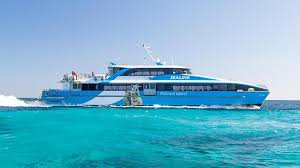Enhancing Customer Accessibility
Improving customer experiences has become a top priority for SeaLink Marine & Tourism. The company aims to create exceptional journeys from the initial booking right up until guests step onboard. With around 5.5 million Australians (about 21.4% of the population) living with disabilities, the integration of digital accessibility is essential in modern tourism, meeting the diverse needs of a broad customer base.
Technological Integration for Improved Access
To enhance accessibility, SeaLink has adopted UserWay, a leading accessibility solution. This feature, accessible through an icon located in the bottom-left corner of the website, personalizes the online experience for users. Some features include:
- Text size and contrast adjustment
- Screen reader compatibility
- Keyboard navigation
- Dyslexia-friendly fonts
- Real-time language translation in 50 languages
In the past year, UserWay has enabled SeaLink to identify and rectify nearly 40,000 online accessibility issues, leading to an impressive digital accessibility score of 95%, surpassing the industry benchmark of 80%. This effort aligns with the Web Content Accessibility Guidelines (WCAG), ensuring the usability of websites for individuals with diverse abilities, including visual, hearing, cognitive, or mobility impairments.
A Commitment to Inclusivity
According to Phil Boyle, Executive General Manager of Customer, Sales and Marketing at SeaLink Marine & Tourism, the endeavor is about creating more compassionate travel experiences. The focus on removing barriers ensures that everyone can access vital travel information, ticketing, and support services, showcasing SeaLink’s commitment to inclusivity.
“Our goal is to meet guests where they are, whether that means language, ability, or location,” Boyle remarked. “By improving accessibility across our websites, we’re enabling everyone to plan and enjoy a brilliant experience.” Key languages such as Chinese, Japanese, and Italian are frequently accessed, illustrating SeaLink’s reach within various communities and among international travelers.
Accessibility Beyond the Digital Sphere
SeaLink’s commitment extends beyond its digital platforms. Vessels and ferry terminals are being constructed or renovated to include accessible features such as wheelchair-friendly ramps, accessible toilets, and priority boarding points. The company’s participation in the internationally recognized Hidden Disabilities Sunflower Program supports a more accepting travel environment. This initiative, which started at Gatwick Airport, has expanded to over 200 airports and tourism providers worldwide.
Boyle emphasized that these steps are crucial in cultivating inclusive travel experiences. SeaLink continues to introduce various upgrades to its fleet, including handrails for stability assistance and smartphone commentary for visually impaired guests. Additionally, certain Captain Cook Cruises vessels in Sydney Harbour offer commentary in multiple languages, including Japanese, Korean, Chinese, Hindi, French, Italian, and German.
Future Developments and Investments
Exciting developments are on the horizon for SeaLink. A $57 million investment will yield new Kangaroo Island ferries that will boast lifts to every vessel level and ensure accessibility across the board. These vessels will also feature designated pet lounges for companion and assistance animals, emphasizing a holistic approach to comfort and inclusivity during voyages.
A Historical Perspective on Accessibility in Tourism
The evolution of accessibility in tourism has undergone significant changes driven by societal shifts and technological advancements. Accessibility used to be a secondary consideration in travel. However, as global awareness of the importance of inclusivity grows, so do expectations from tourists. The focus on facilitating travel for all, regardless of physical ability or language barriers, has become an essential component of the industry.
Increased accessibility has tangible benefits for the tourism sector. Not only does it establish brand loyalty, but it also enhances overall customer satisfaction. For destinations, ensuring universal access helps attract a broader range of visitors, further stimulating local economies. With the ever-increasing demand for diverse tourist experiences, prioritizing accessibility will significantly shape the future of tourism.
The Significance of Technology in Modern Tourism
The integration of information technology has revolutionized how the tourism industry caters to its customers. By leveraging innovative solutions, businesses can improve the quality of service and streamline operations, thus ensuring that travel experiences are smoother from start to finish. Accessible technology not only opens doors for travelers with disabilities but also enhances usability for all guests, making it easier for everyone to engage with travel services.
Conclusione
By integrating innovative technologies to enhance accessibility, SeaLink is setting the standards for inclusive travel experiences in the tourism sector. As the journey towards improved accessibility continues, it serves as a reminder of the necessity of inclusivity in all aspects of travel. Whether it’s through digital advancements or physical upgrades, providing equal access and accommodating diverse needs is essential in today’s tourism landscape. For those interested in sailing and boat adventures, GetBoat.com stands as a premier international marketplace, ready to cater to various needs for boat rentals and sailing experiences, allowing everyone to enjoy the wonders of the sea.

 SeaLink Boosts Accessibility for All Travelers">
SeaLink Boosts Accessibility for All Travelers">
